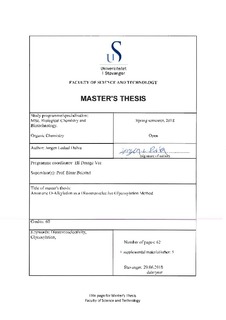| dc.description.abstract | After the Biolink group’s first full synthesis of the anthocyanins cyanidin and delphinidin in which the best results at the time were produced by anomeric O-alkylation of glucose. The Biolink research group was interested in discovering how versatile this reaction truly was. During the synthesis it was discovered that DCM (as solvent) and NaH (as base) yielded great selectivity towards β-glycoside. Bilal Khalid and Raul Manuel Peres later researched the effect of other solvent systems and Bilal discovered that DMF (as solvent) was α-selective and Manuel Peres with Ph.D. Jørn Naimak discovered Cs2CO3 (as base) made the reaction more α-selective in several circumstances.
This thesis aimed to investigate anomeric O-alkylation with new electrophiles and its strengths and weaknesses. Some discoveries were made that several other strong electrophiles that were not in the group of electrophiles previously used by students (acetophenones and α-haloesters) could be reacted with anomeric O-alkylation.
Another aim of the thesis was to find an easy and cheap synthesis of α or β-2,3,4,6-tetraacetate-D-Glucose. Three methods where already in use by the start of this master: Koenings-Knorr on α-1-bromo-2,3,4,6-tetraacetate-D-Glucose using water as nucleophile, ammonium acetate with 1,2,3,4,6-pentaacetate-D-Glucose (peracetylated glucose) in DMF or DMSO and Morpholine and peracetylated glucose in MeCN or before mentioned solvents
What was discovered was one alternate reaction and a new solvent for said reaction, which employed bubbling ammonia through a solution of MeCN or DMF with peracetylated glucose.
Student Katja Håheim (B.Sc.) had faced significant problems with peracetylated sugar as a side product in the reaction. Several key factors for formation of peracetyated sugar was tested and means to mitigate this problem was discovered, a new solvent system for flash chromatography was also discovered to be much more fit to separate products.
Of the glycosides synthesized during this master thesis 2β and 4α glycosides were synthesized that to the authors best knowledge were novel, given below as (*).
Varying yields were observed using the anomeric O-alkylation: ranging from 9-51%.
• 2-(2,3,4,6-tetra-O-acetyl-α-D-glucopyranosyloxy)cyclohexanone (*) (Yield: 35% (purified))
• 2-(2,3,4,6-tetra-O-acetyl-α-D-glucopyranosyloxy)acetonitrile (*) (Yield: 24% (purified))
• 2-(2,3,4,6-tetra-O-acetyl-α-D-glucopyranosyloxy)ethylacetate (Yield: 22% (purified))
• 2-(2,3,4,6-tetra-O-acetyl-α-D-glucopyranosyloxy)benzylacetate (Yield: 39% (purified))
• tert-Butyl 2-(2,3,4,6-tetra-O-acetyl-α-D-glucopyranosyloxy)acetoacetate (*) (Yield: 51% (purified))
• 2-bromo-1-(2,3,4,6-tetra-O-acetyl-α-D-glucopyranosyloxy)prop-2-ene (*) (Yield: 9% (purified))
• 1-(2,3,4,6-tetra-O-acetyl-β-D-glucopyranosyloxy)triphenylmethane (Yield: 30% (purified))
• 2-(2,3,4,6-tetra-O-acetyl-β-D-glucopyranosyloxy)cyclopentanone (*) (Yield: 29% (Purified))
• 1-(2,3,4,6-tetra-O-acetyl-β-D-glucopyranosyloxy)acetonitrile (Yield: 31% (purified))
• 2-(2,3,4,6-tetra-O-acetyl-β-D-glucopyranosyloxy)ethylacetate (Yield: 30% (purified))
• 2-(2,3,4,6-tetra-O-acetyl-β-D-glucopyranosyloxy)benzylacetate (Yield: 27% (Purified))
• 2-(2,3,4,6-tetra-O-acetyl-β-D-glucopyranosyloxy)cyclododecanone (*) (Yield: 50% (purified))
Some products were also produced from the glycoside tertbutyl 2-(2,3,4,6-tetra-O-acetyl-α-D-glucopyranosyloxy)acetoacetate.
• 2-(2,3,4,6-tetra-O-acetyl-α-D-glucopyranosyloxy)acetoacetic acid (*) (Yield: 88%)
• 1-(2,3,4,6-tetra-O-acetyl-α-D-glucopyranosyloxy)propanone and 1-(2,3,4,6-tetra-O-acetyl-β-D-glucopyranosyloxy)propanone in a mixture (Yield: 50%) | nb_NO |
